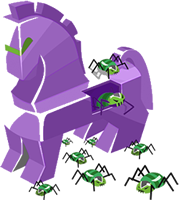Computer Security:
Today, most malware is a combination of traditional malicious programs, often including parts of Trojans and worms and occasionally a virus. Usually the malware program appears to the end-user as a Trojan, but once executed, it attacks other victims over the network like a worm - so it is a hybrid! Many of today's hybrid malware programs are considered as: These malware programs essentially try to modify the underlying operating system so as to take ultimate control and hide from anti-malware programs. They turn your computer into a 'zombie' by using malware to turn your computer into a 'bot'. Bots are essentially Trojan/worm combinations that make individual exploited clients a part of a larger malicious network. Botmasters have one or more "command and control" servers that bot clients check into to receive their updated instructions. Botnets range in size from a few thousand compromised computers to huge networks with hundreds of thousands of systems under the control of a single botnet master. These botnets are often rented out to other criminals who then use them for their own nefarious purposes. To get rid of these types of programs, you must remove the controlling component from memory, beginning with an anti-malware scan. Example
|
|

Custom Search
 Hybrid or Exotic Malware
Hybrid or Exotic Malware 
 of a hybrid:
of a hybrid:

